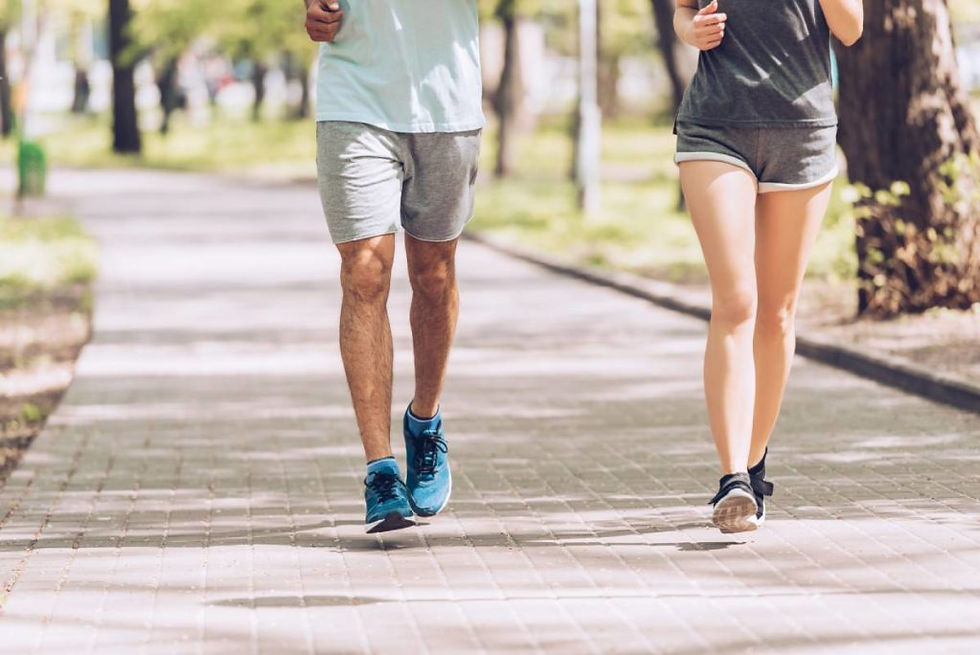RUNNING ON PAVEMENT vs TRAIL
- Team PhysioQinesis : Credit Arpita Pawar
- Oct 18, 2024
- 3 min read

Running is one of the most accessible forms of exercise, but the terrain you choose can significantly impact your experience, performance, and overall enjoyment. While both pavement and trails offer unique advantages and challenges, understanding their differences can help you make informed choices about your running routine.
RUNNING ON PAVEMENT
Pavement provides a uniform surface, allowing for a predictable running experience. This consistency can be beneficial for tracking performance metrics, such as pace and distance. Runners often find that they can maintain a faster pace on pavement due to the firm, even surface. This can be advantageous for training for races or achieving personal bests. Urban environments typically have more paved paths and sidewalks, making it easier to find routes. This accessibility allows for more convenience, especially for those living in cities.
Impact of Forces
Ground Reaction Force (GRF): When your foot strikes the pavement, it exerts a force downwards, and the ground pushes back with an equal force. This GRF is generally greater on hard surfaces like pavement, leading to higher impact forces compared to softer surfaces.
Gravitational Force : On flat surfaces, gravitational force primarily affects your vertical movement. When running uphill, you need to overcome gravitational pull, which requires more energy and engages specific muscle groups.
Friction: Friction between your shoes and the pavement affects acceleration and deceleration. Adequate traction is essential for stability, especially during turns or sudden changes in speed.
Impact on the Body when running on pavement
Joint Stress - The hard surface of pavement increases impact forces on the joints, particularly the knees, ankles, and hips. This can lead to overuse injuries if proper care is not taken.
Muscle Engagement - Pavement running primarily engages the major muscle groups of the legs, including the quadriceps, hamstrings, and calves. While it provides an effective workout, repetitive motion can lead to imbalances.
Injury Risk - High impact forces and repetitive strain can increase the risk of injuries such as shin splints, runner’s knee, and stress fractures. It’s crucial to listen to your body and incorporate recovery strategies.

RUNNING ON TRAIL
Trails often feature different surfaces, including dirt, grass, and rocks, which can improve overall strength and balance as you adapt to the changing conditions. The softer surfaces of trails can reduce the impact on your joints, which may help in preventing injuries commonly associated with pavement running. The uneven surfaces and elevation changes often lead to slower running times compared to pavement. This can be a disadvantage for those training for speed.
Impact of forces
Ground Reaction Force (GRF) : On uneven surfaces, the GRF can vary significantly with each step. The stability of the ground influences how forces are absorbed, impacting how your body responds to shocks and joints.
Gravitational Force
a. Uphill Running: Climbing inclines increases the gravitational force you must work against, requiring greater energy expenditure and engaging specific muscle groups, particularly the quads and glutes.
b. Downhill Running: Descending requires control to manage gravity’s pull, which can increase speed but also strain your knees and require careful technique to avoid falls.
Impact on the Body when running on trail
Joint Stress :The unpredictable surfaces can increase the risk of sprains and strains. While softer trails may reduce impact, the uneven terrain can also lead to ankle rolls and other injuries.
Muscle Engagement :Trail running activates a wider range of muscles than road running due to the need for stabilization on uneven ground. This includes the core, hips, and lower legs, leading to improved overall strength.
Balance and Proprioception : Running on trails enhances proprioception (awareness of body position) and coordination, improving your ability to navigate complex environments and reducing fall risk.
Running on pavement or trail has its pros and cons. If your body mechanics are correct while running, the chances of injury are less. However, improper running mechanics can lead to problems.

Comments